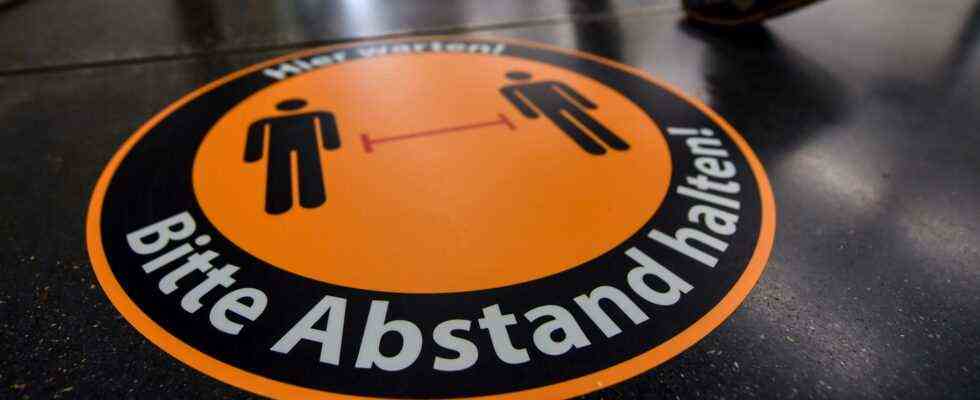Status: 11.11.2021 09:27 a.m.
In the case of the corona measures, simple measures such as the distance requirement and mask requirement are currently dependent on an epidemic situation. That is now about to change – and the countries are given more powers. To this end, the Infection Protection Act is to be changed for the third time.
At the beginning of the pandemic, the federal states’ corona measures only had a very vague legal basis. Whether contact restrictions, company closings or curfews – everything was based on Section 28 of the Federal Infection Protection Act in spring 2020. A so-called general clause without any particularly specific prerequisites. Over the course of the months, the Bundestag changed the legal basis several times – now another change is pending. From the point of view of the traffic light groups, there should be a further adjustment “up to a fundamental revision” of the Infection Protection Act.
Review: the first changes
For a better understanding, first a look back: During the summer of 2020, courts increasingly expressed doubts that the general clause of the Infection Protection Act is actually sufficient as a permanent legal basis for all the corona measures of the federal states.
Because the system is like this: The state governments can make rules on infection protection by ordinance – but only within the framework that the federal legislature specifies. This means that the federal states need a legal basis for their corona measures, which the Bundestag must adopt. And the general clause in Section 28 of the Infection Protection Act would probably not have been sufficient as a legal basis in the long term.
In November, the legislature finally reacted and added Paragraph 28a to the Infection Protection Act. The new regulation contains an extensive, detailed catalog of the corona measures the federal states can adopt – from the mask requirement to contact restrictions to company closings. A prerequisite for all these measures was and is: the establishment of an epidemic situation of national scope by the Bundestag. A statement that the Bundestag made for the first time at the end of March 2020 and has since extended repeatedly. Last on August 25 for another three months.
Federal emergency brake: entry into force and expiry
The federal states made very different use of the possibilities given to them in the catalog. When the number of infections continued to rise over the past winter, the call for nationwide uniform corona measures was loud. Thereupon the Bundestag, as parliamentary legislature, issued the so-called “Federal Emergency Brake”. Another paragraph was added to the Infection Protection Act: 28b. It compulsorily stipulated certain corona measures nationwide by federal law – in contrast to the measures taken by the states by the state governments by ordinance. Implementation by the federal states was no longer necessary.
The exit and contact restrictions, schools and business closings automatically applied from a seven-day incidence of 100. At the end of June, the federal emergency brake was overridden as planned. At this point in time, the number of infections had been below the threshold of 100 for a long time, so that the measures no longer applied anyway. Corona measures without an epidemic situation.
The traffic light groups now want to change the Infection Protection Act again. Since bills can also be introduced “from the middle of the Bundestag” and the newly elected Bundestag has already met, the SPD, Greens and FDP can propose the changes and pass them with their majority. It does not matter that they have not yet formed a new federal government. Laws are passed by the Bundestag together with the Bundesrat.
The background to the planned change is that the traffic light groups do not want to prolong the epidemic situation. This is because the Federal Government has special powers to issue statutory ordinances. The SPD, Greens and FDP write in their draft law of “executive special rights” – “extensive competences”, “whose compatibility with the constitutional basis is subject to increasing doubts as the pandemic lasts”.
Countries: measures with “low level of intervention”
Because the end of the pandemic is not yet in sight, the federal states should in future be able to at least take corona measures with a “low level of intervention” regardless of whether an epidemic has been identified. In other words: measures that only slightly restrict fundamental rights. According to the draft law, these should include: distance requirements, mask requirements, 2G and 3G proof requirements in connection with access restrictions, for example in restaurants or hotels, hygiene concepts – also with upper limits for people, contact tracking in restaurants and at events, requirements for schools, universities and daycare centers.
This means that there will continue to be a uniform federal legal basis for corresponding corona measures by the federal states – but whether and how the federal states make use of them is up to them. In spite of the uniform national legal basis – as before – there may be regionally different rules.
However, the federal states can no longer impose a lockdown of the type that existed last year, with schools and businesses being closed – or only if an epidemic situation of national significance is found again.

